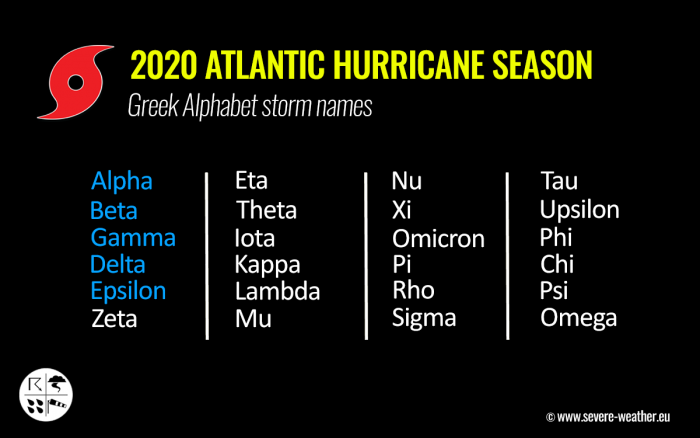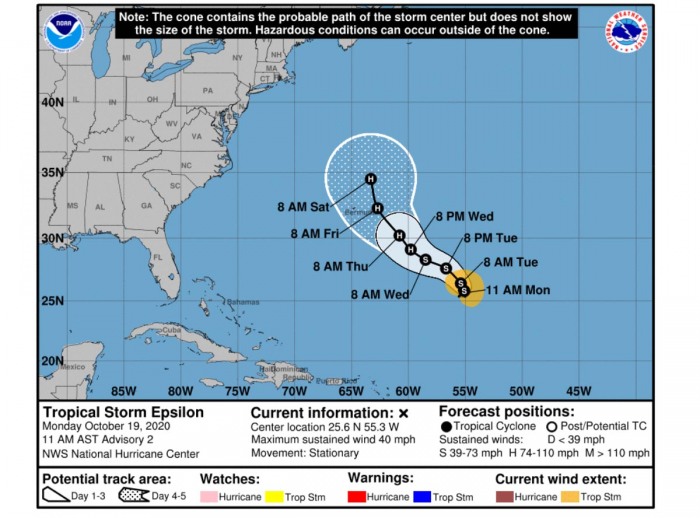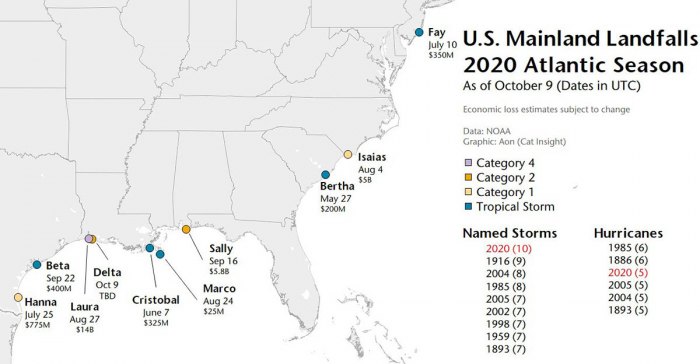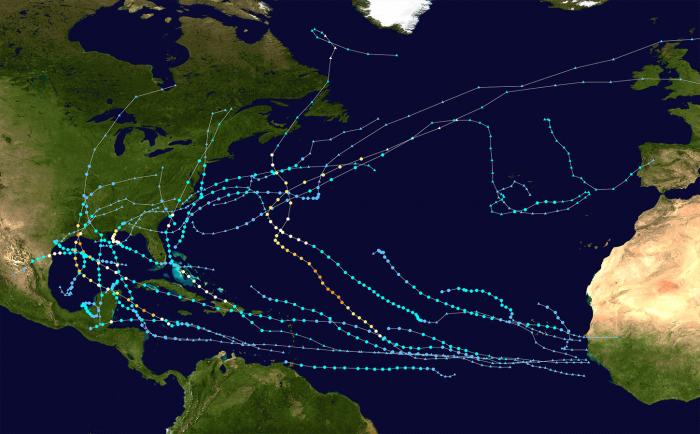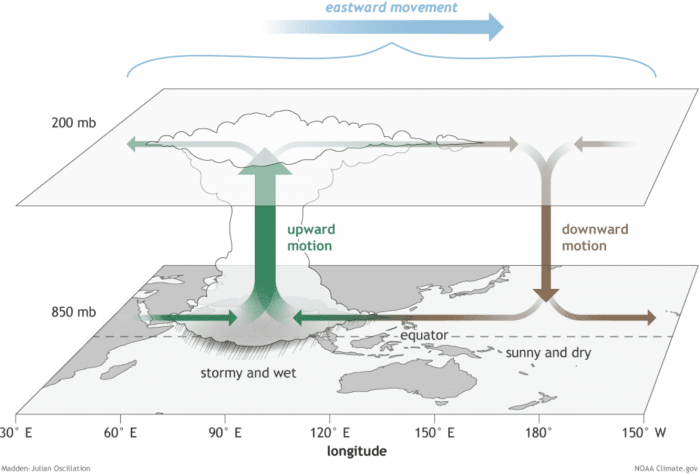Atlantic hurricane season 2020 just set another record today, the earliest 26th named storm formation – Tropical Storm Epsilon formed on Monday. The system is gradually gaining strength while slowly moving west. Epsilon is expected to pass very near Bermuda late this week. At the same time, strong rip currents will spread towards the East Coast of the United States.
A favorable MJO wave is now emerging from the west (Eastern Pacific), so the atmospheric conditions are becoming much more conducive for tropical development through late October into early November. Both across the western Atlantic and the Caribbean Sea.
A Tropical Storm Epsilon formed several hundred miles southeast of Bermuda today.
Epsilon is the 26th named storm of the 2020 Atlantic hurricane season – the earliest 26th named storm formation on record, beating the previous record from November 22nd, 2005 (storm Delta). So more than a month earlier than in the record season 2005, this is just showing how active this year’s season is.
Epsilon is also the 3rd named storm formation in the Atlantic this October (Gamma and Delta were the other two). And this is also only the second time in recorded history that the Atlantic has seen a tropical storm named Epsilon.
EPSILON ON THE WAY TO BERMUDA
The center of the Tropical Storm Epsilon has become a very well-defined on Monday morning, with convective banding over the northern and eastern portions of the circulation. The structure is improving, indicating the storm is gradually intensifying.
Although earlier today, Epsilon had a hybrid-type structure in the satellite imagery. But the infrared satellite imagery now indicates a convective burst near the center. This gives Epsilon a more tropical appearance.
Based on the Dvorak analysis classification the former system twenty-six was upgraded to a 35-knot (40 mph) tropical storm. The minimum central pressure is around 998 mbar.
Storm Epsilon is located within an environment of moderate southwesterly to westerly vertical wind shear and over very warm sea waters of the Western Atlantic. These conditions should allow for gradual strengthening over the next 24-48 hours.
By Wednesday, the vertical wind shear will be decreasing and allow Epsilon to begin a more significant intensification and grow larger in size.
The system is meandering within an area of weak steering currents near the base of the upper-level trough that extends southwestward from the northeastern Atlantic.
Changes in the synoptic pattern should cause Epsilon to begin accelerating with faster forward speed towards west-northwestward by mid-week. Tropical Storm Epsilon is expected to continue intensifying while gradually moving towards Bermuda.
The system is forecast to be at or near hurricane strength (most likely a Category 1) when it approaches Bermuda late this week.There is an increasing concern for direct impacts from wind, rainfall, and storm surge on Bermuda.
It has to be noted that Epsilon could even make landfall in Bermuda with a hurricane-strength (as hurricane Paulette did in mid-September), but uncertainties remain regarding its potential track in the coming days. The most likely track scenario, for now, brings Epsilon center to the east of Bermuda.
Tropical Storm Epsilon should be no immediate threat to the United States East Coast. But it will generate high swells and rough surf towards the East Coast, Florida, the Bahamas, and also towards Hispaniola, Puerto Rico, the Virgin Islands, and the Leeward Islands.
The above video reveals that Epsilon could become a quite large hurricane while passing near Bermuda late this week. The animation includes significant sea wave heights.
After the closest approach to Bermuda on Friday, Epsilon is forecast to turn northeast while gradually becoming an extratropical storm and begin accelerating into the Northwest Atlantic.
The remnants of Epsilon could also re-intensity over the North Atlantic and head towards Europe – we will be closely monitoring its evolution and the potential impacts later on.
RIP CURRENTS FOR THE EAST COAST AND FLORIDA
While Epsilon is far from the East Coast of the United States, it will also generate high swells and rough surf towards the East Coast. But there is another risk for the Atlantic coast this week – the coastal flooding and an increased rip current threat for the coasts of South Carolina, Georgia, and eastern Florida.
A strong high-pressure system forms across the eastern contiguous United States, leading to northeasterly onshore wind over the southeastern Atlantic coast this week. The large difference in surface pressure between this high-pressure system and an area of lower pressure to its south will strengthen the winds towards the coastal areas.
These winds will combine with high tides which should result in rising sea levels quite significantly for much of the Florida coast. Therefore, likely also leading to coastal flooding.
Some coastal flooding has already been reported in the Florida Keys on Monday.
These conditions are expected to persist until the weekend when pressure difference vanishes and weakens the onshore winds. Coastal waters will then return to near-normal levels.
HURRICANE SEASON IS NOT OVER YET
The official hurricane season for the Atlantic Basin (the Atlantic Ocean, the Caribbean Sea, and the Gulf of Mexico) is from June 1st to November 30th. The peak of the season is from mid-August to late October.
By October 19th, the 2020 hurricane season now still has about 40 days left until we close the books at the end of the season.
At the beginning of the hurricane season, NOAA, TWC, and NCSU forecasters predicted: “There will be 13 to 22 named tropical storms in 2020, where 6-9 of those would reach hurricane strength, and 3-4 of them attaining major strength.” The official name list had 23 names reserved this year.
As of Sept 18th, the list usage has been completed as all the reserved names were already used by that date. Since then, the Greek alphabet list is in use.
Now, as Tropical Storm Epsilon has formed, there is the next name ready – Zeta. Once it forms, the 2020 season will have 27 storm names used and the season will be tied with the storm names used in 2005. Zeta was the last Greek alphabet letter used for a named storm in the 2005 hurricane season.
The 2020 hurricane season is, therefore, very likely on the way for a new record for the most named storms in one season. Past 28 named storms from 2005 – the only year using the Greek alphabet until now. 2005 hurricane season churned out powerful hurricanes Katrina, Rita, and Wilma.
LOW-PRESSURE SYSTEM IN THE CARIBBEAN
The Western Caribbean region remains closely monitored as the weather models continue to forecast a potential tropical development. Model guidance is growing concerns as a broad area of low pressure – called a Central American Gyre – has formed near Central America.
The extremely warm Caribbean Sea waters are, combined with the strengthening upper-level divergence beneath the emerging MJO wave, conducive for tropical development over the next week or two.
A disturbance is forecast to move slowly westward toward the Yucatan peninsula (Mexico) over the next two days. Regardless of development, the system could bring locally heavy rainfall to portions of Cuba through mid-week days.
If conditions will support a tropical-storm-force system, it would become a Tropical Storm Zeta. However, models are for now giving it lower chances for development. Conditions will continue to be monitored further.
HOW IS THE HURRICANE SEASON SO FAR?
The Atlantic hurricane season has been a record-setting for named storms to date, Oct 19th. There were 26 named storms, which is nearly 250 % of the long-term average (10.6) for this time period. So far, there were almost double the number of hurricanes (9) and three major hurricanes (Laura, Teddy, and Delta). 24 storms out of those 26 total, had the earliest formation date on record.
Major hurricanes Laura, Teddy, and Delta have all peaked at Category 4 strength. Laura and Delta both made destructive landfalls in Louisiana. Delta’s center came ashore on October 9th and, interestingly, the landfall was just about 15 miles east of the landfall point of Hurricane Laura, which struck at the end of August.
Laura made landfall as a Category 4, while Delta was a Category 2 when it came ashore. The same areas were severely damaged by both storms.
The Atlantic, Caribbean region, the Gulf of Mexico, and the East Coast of the United States were also the most active tropical regions globally this year.
There have been 87 named storm days, which is around 170 % of the average number (51.4). As we can see the October 12th graphics below (see the right column), all the forecast parameters are above average. Including hurricane days, major hurricanes, and major hurricane days. Provided graphics are by Dr. Philip Klotzbach.
Accumulated Cyclone Energy (ACE index)
The Accumulated Cyclone Energy is the energy output of a hurricane season, calculated as an index (ACE index). It is a metric used to express the energy used by a tropical cyclone during its lifetime.
The index calculation takes the cyclone’s maximum sustained winds every six hours and multiplies it by itself to generate the values. The total sum of these values is calculated to get the total for a storm.
The current Atlantic basin ACE is, as of October 12th, held at 123. That is almost 40 percent higher than during a normal season to this date.
The highest ACE so far this season was generated by Teddy (27.8), Paulette (15.9), Delta (15.7), and Laura (12.8).
But there is more. The 2020 Atlantic hurricane season has had a record-breaking 10 landfalls of tropical storms (or hurricanes) in the United States mainland this season. Hurricane Delta has helped the season to break the previous record of nine landfalling systems almost 100 years ago – in 1916.
Hurricane Delta was the first hurricane named after a Greek alphabet letter use which made landfall on the United States mainland. These are 10 named storms that made landfall in the continental United States this year (2020): Bertha, Cristobal, Fay, Hanna, Isaias, Laura, Marco, Sally, Beta, and Delta.
The 2020 hurricane season has also tied another record – there were 3 tropical storm formations in a single day. Tropical Storm Wilfred, Subtropical Storm Alpha, and Tropical Storm Beta formed on Sept 18th. This has happened only once before, in 1933.
The graphics below show all the tropical storm tracks for the 2020 Atlantic Hurricane season so far. The image is provided by Wikipedia, based on the official data from the National Hurricane Center (NHC).
A NEW MJO WAVE IS ENTERING FROM THE WEST
So, what can we expect for the rest of October and early November in this hurricane season? The sea surface temperatures remain very warm in the Western Atlantic, and extremely warm over the Caribbean region. There, the sea surface temperatures are reaching about 30 °C (86 °F). Even around 31 °C (87 °F) around Cuba.
This is definitely a worrying sign as sea waters remain much higher than the long-term average. So the upcoming tropical systems will have the most important ingredient ready, therefore strongly supporting the rapid development of storms.
Actually, the majority of the North Atlantic, tropical Atlantic, and the Caribbean are well-above average. Also the Eastern Pacific. About 1-2 °C warmer, even more across the Northwest Atlantic.
There are some slightly cooler waters over the northern portions of the Gulf of Mexico and around Bermuda – this is the upwelling and cool Eddie left behind hurricanes Teddy, Laura, and Delta.
Notice also a rapidly cooling water of the Eastern and Central Pacific – a strong Lá Nina is developing. See details:
But what is the MJO?
The Madden-Julian Oscillation (MJO) is the largest and most dominant source of short-term tropical variability, it is an eastward-moving wave of thunderstorms, clouds, rain, winds, and pressure. It circles the entire planet on the equator in about 30 to 60 days.
At the end of October, a new wave will re-emerge from the eastern Pacific into the Caribbean region. It will also extend into early November.
The MJO consists of two parts: one is the enhanced rainfall (wet) phase and the other is the suppressed rainfall (dry) phase. This means there are increased storms and rainfall on one side and reduced storms and drier weather on the other side.
The air parcels are diverging (moving away) over the wet phase, and converging (moving together) over the dry phase. This horizontal movement of air is referred to as the Velocity Potential (VP) in the tropics.
We are able to track the entire MJO wave movement by looking at the larger scale air parcels movement. With the weather model data, we can easily see the areas where the air is rising and where it is subsiding.
Another important factor is the Ocean Heat Content (OHC). OHC takes into account the depth of the sea, and how warm the water layers are deep below the sea surface. In this month, we can still see a large pool of high available heat energy with a very warm water layer running down quite deep.
Deepwater being so warm as this season, provides a very favorable environment of a thick layer of warm water. Tropical systems are fueled by these warm layers, as deep convective storms draw energy from hot water.
Long story short: the thicker the warm layers are, the more fuel/energy is available to feed the storms.
The above graphics, provided by Michael J. Ventrice, Ph.D. represent an MJO wave with filtered VP200* anomalies for the current state, for the week 1 forecast, and for the week 2 forecast. Cold colors are representative of a more favorable state over the Atlantic for tropical cyclogenesis while warm colors represent a less favorable state for tropical cyclogenesis.
*VP200 – means a Velocity Potential (VP). It is an indicator of the large scale divergent flow, so at upper levels in the tropics. The negative VP anomalies (shaded blue in the diagram) are closely tied to the divergent outflow from enhanced convective regions.
It is an obvious sign that during the week 2 forecast (end of October), the MJO wave will emerge into the Caribbean region, lowering the pressure and providing a strong boost to thunderstorm activity.
HISTORY OF OCTOBER HURRICANES
With the typical October occurrence, more westerly prevailing winds are forecast to develop across the central and eastern United States. This tends to keep any potential tropical systems away from the western parts of the Gulf of Mexico.
Such steering winds and circulations more likely lead to the formation of the tropical systems over the Caribbean, moving towards the Bahamas and Florida, and further along the East Coast of the United States.
And late October has a history of some powerful hurricanes, originating from the Caribbean region and moving towards the United States, e.g. Sandy (2012), Wilma (2005), or Mitch (1998).
Also, Hurricane Michael, which made a destructive landfall as a Category 5 hurricane in Florida Panhandle on October 10th, 2018. Michael was the first Category 5 hurricane to strike the United States mainland since Andrew back in 1992.
The below map, based on the NHC past data, is showing where Atlantic named storms have formed over the second half of October (Oct 14th to 27th) during the satellite era (since 1966). It is an obvious fact that all the major hurricanes (Category 3 or greater) have formed in the central or western Caribbean Sea region.
In 2020, the Western Caribbean region greatly fit into the statistics, as both Tropical Storm Gamma and Hurricane Delta originated in the Caribbean.
The average trajectory of the tropical systems tracks in October is towards the north and northeast. This puts Florida at risk of landfall if storms organize. Actually, the month of October is the statistical peak of tropical storm landfalls in Florida.
So a typical October brings storm tracks closer to land, from the western Caribbean Sea to the eastern Gulf of Mexico, Florida, and also the East Coast of the United States.
RECORD YEAR WITH MORE THAN 30 NAMED STORMS?
With the tropical storm Epsilon now active, there is only one name left to align with the existing record of 6 Greek alphabets used in 2005. Tropical Storm Zeta was the last storm name that was designated by the National Hurricane Center in 2005, the only year using the Greek alphabet prior to the 2020 Atlantic hurricane season.
Based on the current statistics, the Atlantic hurricane season 2020 is only two named tropical storms away from the record of 28 named storms in 2005. For example, the 2005 season had eight (8) additional storms forming in October itself and a few more later, even past the official end of the season.
With potentially a few more storms forming in November, we are definitely aiming towards Nu or Xi storm names. That is halfway through the Greek Alphabet names.
There seems to be a fairly high probability that the well-above-average western Atlantic and Caribbean region sea temperatures would be favorable for tropical storm formation even in December this year.
Nevertheless, there is still a long way to go before we will be closing the books of this historic 2020 Atlantic hurricane season.
